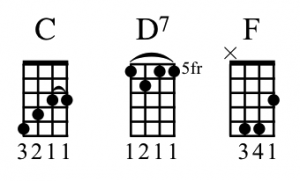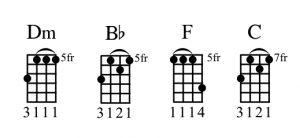I’m sure you’ll have read a few of those Tourist Board type potted histories of the ukulele. But they’ve always left me with tons of questions. So I decided to put those questions to someone who has looked into it properly.
Jim Tranquada has just completed a book on ukulele history that he and John King were working on at the time of his death. He’s also on the board of the Ukulele Hall of Fame, is great-great grandson of Augusto Diaz and, as you’re about to see, has some fascinating stuff to say about the ukulele.
I can’t think of a comprehensive ukulele history before. What was the impetus for embarking on it and how did you go about researching it?
A. Ten years ago, both John and I were pursuing our own research on opposite sides of the country, unaware that we were doing the same kind of work. John, trained as a classical guitarist, had published on the history of the guitar, and couldn’t understand why the same kind of serious research hadn’t been done on the ‘ukulele.
My impetus was curiosity about whether the family stories about my great-great grandfather, Augusto Dias, were true or not – that he was supposedly one of the Madeiran immigrants who introduced the ‘ukulele to Hawai’i. In January 2002, I stumbled onto John’s NALU Music site, immediately e-mailed him about the research I had been doing, and we quickly began a regular correspondence sharing our peculiar obsession.
I had already decided to try and write an article for the Hawaiian Journal of History, and John graciously agreed to join forces. As soon as that piece was finished, we both had the same idea: there’s a book in this. With a few honorable exceptions, including Jim Beloff’s pioneering book, most of the history published in print and online up to that point was a rehash of the same small group of secondary sources, plus an accretion of anecdote and speculation. We wanted to go straight to the source, and rely on contemporary records whenever possible.
Our research methodology was simple: look at anything we could get our hands on that remotely might have anything to do with the ‘ukulele: newspapers, magazines, city directories, court, church, tax, immigration and census records, oral histories, business records, catalogs, brochures and other ephemera, sheet music, songbooks, copyright registrations, auction records, ebay listings, novels and short stories, and movies and newsreels.
When is the book coming out and how can we get hold of it?
I’m still working on rounding up all the illustrations, but the text is done and if all goes according to plan the University of Hawai’i Press will be able to bring it out next year. Anyone should be able to order it from a local bookstore, Amazon, or direct from UH Press.
What would you say was the most important moment in the history of the ukulele?
That’s a question that will trigger an endless string of arguments. Looking back over the past 130 years, one thing that has fascinated me is not a particular moment in time, but the repeated role that technology has played in popularizing this little acoustic instrument.
After the turn of the century, phonograph records played an important role in building a fad out of the ‘ukulele and Hawaiian music, first on the West Coast and then nationwide.
After 1922, the ‘ukulele was a major beneficiary of the explosive popularity of radio, which made is possible for it to be heard effortlessly in a way that wasn’t possible on stage.
In the early 50s, it was the new medium of television that Arthur Godfrey used as a platform to spread the gospel of the ‘ukulele. (The ‘ukulele was associated with TV from the very beginning: the first public demonstration of television in 1928 featured radio announcer Louis Dean strumming a ‘ukulele and singing “Ain’t She Sweet?”)
And today, it’s the Web that has helped fuel the so-called third wave, giving the international ‘ukulele community a tool to build that community. John and I met each other online, and it wasn’t until we had been collaborating for more than two years that we met in person.
What’s the biggest misconception about the history of the ukulele?
I’ve always been surprised by the number of people I’ve met who didn’t know that the ‘ukulele was introduced to Hawai’i from Madeira. The myth of its native Hawaiian origins has been debunked many times, but the ‘ukulele has been so closely associated with the Islands for so long that it has become the misconception that will never die.
The ukulele went from foreign invention to the heart of the Hawaiian tradition in a very short time. Why was it adopted so quickly? And why was it so enthusiastically accepted by the royal family?
Then as now, the ‘ukulele had the attractive benefits of being small, portable, and easy to tune and play. The Madeiran practice of street serenading was shared by the Hawaiians, who were engaged in a growing love affair with the guitar in the last quarter of the 19th century.
Many members of the royal family, including the “heavenly four” – Kalakaua, Lili’uokalani, Likelike, and Leileiohoku – were talented musicians and multi-instrumentalists. Leileiohoku died in 1877 and Likelike ten years later, but there are contemporary accounts that show that Kalakaua and Lili’uokalani both played the ‘ukulele. Royal patronage has always been an effective marketing tool for almost anything.
However, it’s also important to consider the broader social and political context into which the machete was introduced: a period of convulsive political conflict that pitted native Hawaiians against a powerful haole elite. At stake was nothing less than the fate of the monarchy and Hawaiian independence. That’s why we believe that the most significant change the original ‘ukulele makers made was their decision to make all-koa instruments, in defiance of European convention.
Koa was intimately associated with the monarchy in the nineteenth century: the first royal throne was made of koa; the cradle for the heir of Kamehameha IV was made of koa; Hawaiian royalty slept in koa beds and was buried in koa coffins. Koa appealed directly to the patriotism of native Hawaiians, one of the reasons both Jose do Espirito Santo and Dias advertised instruments “made of Hawaiian wood.” An all-koa ‘ukulele was a symbol of aloha aina – love of the land – at a time when Hawaiian sovereignty was threatened.
With all the hardship it entailed, why did the original uke makers leave Madeira for Hawaii.
By the time my great-great grandfather was in his late thirties, he had survived a cholera epidemic, a prolonged famine, and two plagues that devastated the vineyards that were then the basis of the Madeiran economy. Poverty, famine, and overpopulation triggered massive emigration, much of it illegal, beginning in the 1830s to such places as Demerara (today’s Guyana). The emigration to Hawai’i was simply part of a larger pattern that had begun decades earlier.
How did the uke’s image turn from being associated with Hawaii to adoption by flappers and other jazzy types?
You can begin to see the shift as early as 1909, when Oliver Ditson came out with T.H. Rollinson’s ‘ukulele method — the first published on the mainland. The first method by Ernest Kaai, which had come out three years earlier, contained almost all Hawaiian songs; Rollinson’s had only American tunes.
The biggest market for both methods was on the West Coast, where the ‘ukulele was adopted early by college students: it began making appearances at Stanford, Berkeley and Mills as early as 1900. By 1914, glee clubs at Princeton, MIT and Dartmouth were featuring ‘ukulele in performances.
The popularity of the ‘ukulele after the Pan-Pacific International Exposition in San Francisco in 1915 was based in part on the fact that it was already being played by young people all across the country. (For Christmas 1914, for example, you could have bought a ‘ukulele in Cleveland, Des Moines, Tucson, Portland, Ore., or Racine, Wisc.)
When you think about it, the ‘ukulele is an ideal instrument for teenagers: small, portable, relatively inexpensive, easy to play, and, judging from the amount of abuse aimed at it throughout the 20s, annoying as hell to lots of adults.
The Ukulele Hall of Fame hasn’t had any inductees for a few years. Is it still a going concern?
It is. I serve on the board, and while there hasn’t been an induction recently, other programs are still active, including the website and our grant program to help fund the purchase of ‘ukuleles for classroom instruction. Tom and Nuni Walsh deserve much of the credit for keeping the UHOF a going concern.
There’s recently been a campaign to include Tiny Tim in the Ukulele Hall of Fame. How do you feel about his contribution to the ukulele?
If you read contemporary news coverage of Tiny Tim’s career, you find that the first reactions to him were just as evenly split as opinion is today. Life magazine compared his first album to Sgt. Pepper, while Time called him “the most bizarre entertainer this side of Barnum & Bailey.” Reviewers rarely said anything about his ‘ukulele playing, focusing instead on his long hair, fluttering hands, falsetto voice, and unconventional lifestyle. He certainly had an encyclopedic knowledge of early Tin Pan music, and there’s no question that he defined the ‘ukulele for modern American audiences, just as George Formby defined it in England.










